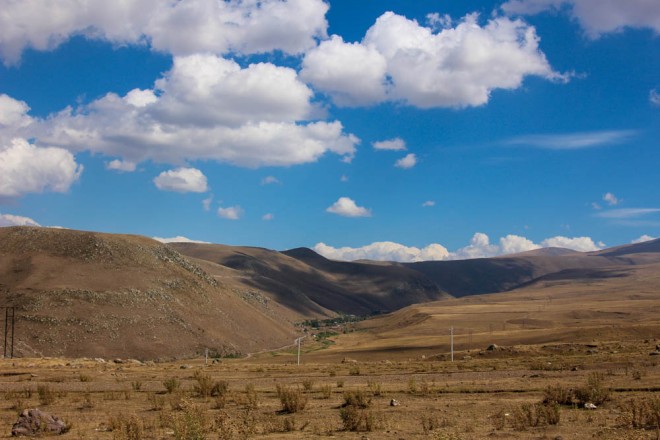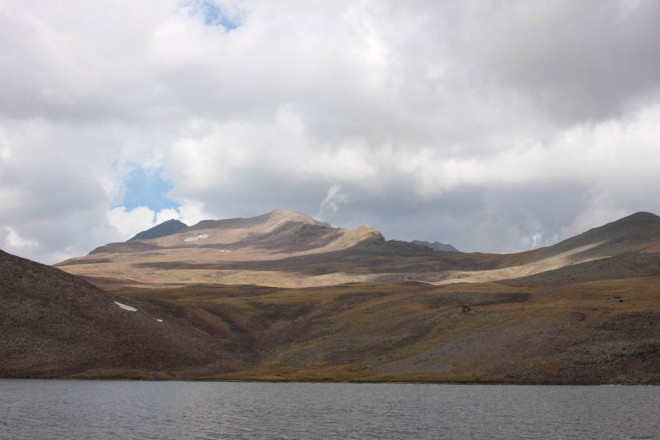Enjoying the journey, wherever it may take us. Image by Polly Barks.
I stood on the side of a mountain, surveying the beautiful land with half-awe, half-frustration. We were headed toward a small mountain lake, but what was supposed to be an hour-long trip had extended beyond two as it turned more into a game of avoiding massive potholes than any substantive movement.
We had finally pulled over next to a nondescript path marked with a bit of Armenian and an arrow. We were firmly off the tourist path (and the reach of Google Maps), so we had no idea what to expect. Figuring whoever (or whatever) was at the end of the path must have some idea where we’d gone wrong, we set off with gravity pushing us down the hill.
After a short walk we came to yet another sweeping vista filled with placid cows. This time, though, a slight man sat behind a table stacked with jars of honey, looking for all the world as if he were in the middle of a busy market rather than on the side of a mountain with the closest town many kilometers away.
Do you know where Lake Kari is?
We tried English. We tried Russian. We tried pronouncing ‘Kari’ with every accent and inflection possible. No amount of inflection could get the man to do anything more than gesture towards the honey with a large smile and a long flow of delightfully unintelligible Armenian.
So we did what any sensible people would do: We gave up and bought some honey. We still had no idea where we were or if we’d ever be able to get our car down the mountain, but, damn, was that honey good.
So cheers to that non-updated guidebook and those awful roads. Otherwise, I’d never have discovered the best honey of my life.

We’re here! But where’s here? Image by Polly Barks.
It’s an unfortunate fact, but for many, the epic journey is no longer en vogue. I’m not suggesting we all need to be the next Marco Polo (who began his travels across the world at the tender age of 17) or Ibn Battuta (a Muslim geographer who traveled all across Europe and Asia in the 14th century), but a return to yesteryear’s emphasis on discovery in travel would certainly be a step in the right direction.
In the end it seems like what modern travel’s missing is the element of surprise.
As I read through countless travel recaps and hear about recent trips from friends, one thing always stands out: the orgy of planning that takes place beforehand. TripAdvisor is scoured. Travel blogs and guidebooks are poured over. Meticulous lists are curated and locked into their technological device of choice. Nothing is left to chance.
I’m not knocking being prepared (although in the interest of full disclosure, I’m chronically under-prepared), but modernity’s access to so much information seems to take much of that joyful discovery out of travel. I’m sure Marco Polo was incredibly impressed by the Silk Road, since he hadn’t spent hours building up his expectations on Pinterest the week before he left.
That’s why I advocate so strongly for slow travel.
Slow travel means leaving yourself enough mystery that you’ll be able to experience the joy of discovery and maybe even enjoy a radical change of plans. Most importantly, slow travel, for me at least, means that the actual traveling is the longest and most meaningful part of your journey. Regardless of whether you’ve got a weekend or a whole season for your next adventure, slow travel is absolutely possible by heading into a trip with an open mind and a willingness to make and break plans as you go along.
For a wonderfully refreshing take on modern versus historical travel trends (and embracing slow travel), have a look at Hidden Europe’s A Manifesto for Slow Travel.
I think it’s about time we start to reclaim the art of losing yourself. Leave a little buffer in your plans for chance, and just maybe toss your carefully made lists out the window for a bit.
After all, how else will you discover the world’s greatest honey?

Incidentally, we did finally find the lake. And bottomed out our car several times along the way. Image by Polly Barks.
